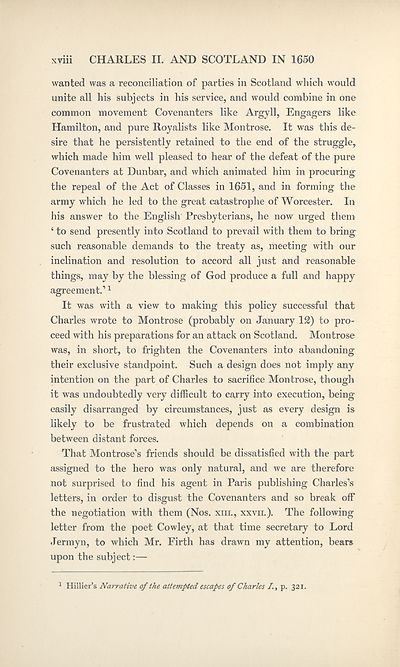Series 1 > Letters and papers illustrating the relations between Charles the Second and Scotland in 1650
(23) Page xviii
Download files
Complete book:
Individual page:
Thumbnail gallery: Grid view | List view

xviii CHARLES II. AND SCOTLAND IN 1650
wanted was a reconciliation of parties in Scotland which would
unite all his subjects in his service, and would combine in one
common movement Covenanters like Argyll, Engagers like
Hamilton, and pure Royalists like Montrose. It was this de¬
sire that he persistently retained to the end of the struggle,
which made him well pleased to hear of the defeat of the pure
Covenanters at Dunbar, and which animated him in procuring
the repeal of the Act of Classes in 1651, and in forming the
army which he led to the great catastrophe of Worcester. In
his answer to the English Presbyterians, he now urged them
‘ to send presently into Scotland to prevail with them to bring
such reasonable demands to the treaty as, meeting with our
inclination and resolution to accord all just and reasonable
things, may by the blessing of God produce a full and happy
agreement.’1
It was with a view to making this policy successful that
Charles wrote to Montrose (probably on January 12) to pro¬
ceed with his preparations for an attack on Scotland. Montrose
was, in short, to frighten the Covenanters into abandoning
their exclusive standpoint. Such a design does not imply any
intention on the part of Charles to sacrifice Montrose, though
it was undoubtedly very difficult to carry into execution, being
easily disarranged by circumstances, just as every design is
likely to be frustrated which depends on a combination
between distant forces.
That Montrose’s friends should be dissatisfied with the part
assigned to the hero was only natural, and we are therefore
not surprised to find his agent in Paris publishing Charles’s
letters, in order to disgust the Covenanters and so break off
the negotiation with them (Nos. xin., xxvn.). The following
letter from the poet Cowley, at that time secretary to Lord
Jermyn, to which Mr. Firth has drawn my attention, bears
upon the subject:—
Hillier’s Narrative of the attempted escapes of Charles /., p. 321.
wanted was a reconciliation of parties in Scotland which would
unite all his subjects in his service, and would combine in one
common movement Covenanters like Argyll, Engagers like
Hamilton, and pure Royalists like Montrose. It was this de¬
sire that he persistently retained to the end of the struggle,
which made him well pleased to hear of the defeat of the pure
Covenanters at Dunbar, and which animated him in procuring
the repeal of the Act of Classes in 1651, and in forming the
army which he led to the great catastrophe of Worcester. In
his answer to the English Presbyterians, he now urged them
‘ to send presently into Scotland to prevail with them to bring
such reasonable demands to the treaty as, meeting with our
inclination and resolution to accord all just and reasonable
things, may by the blessing of God produce a full and happy
agreement.’1
It was with a view to making this policy successful that
Charles wrote to Montrose (probably on January 12) to pro¬
ceed with his preparations for an attack on Scotland. Montrose
was, in short, to frighten the Covenanters into abandoning
their exclusive standpoint. Such a design does not imply any
intention on the part of Charles to sacrifice Montrose, though
it was undoubtedly very difficult to carry into execution, being
easily disarranged by circumstances, just as every design is
likely to be frustrated which depends on a combination
between distant forces.
That Montrose’s friends should be dissatisfied with the part
assigned to the hero was only natural, and we are therefore
not surprised to find his agent in Paris publishing Charles’s
letters, in order to disgust the Covenanters and so break off
the negotiation with them (Nos. xin., xxvn.). The following
letter from the poet Cowley, at that time secretary to Lord
Jermyn, to which Mr. Firth has drawn my attention, bears
upon the subject:—
Hillier’s Narrative of the attempted escapes of Charles /., p. 321.
Set display mode to:
![]() Universal Viewer |
Universal Viewer | ![]() Mirador |
Large image | Transcription
Mirador |
Large image | Transcription
Images and transcriptions on this page, including medium image downloads, may be used under the Creative Commons Attribution 4.0 International Licence unless otherwise stated. ![]()
| Scottish History Society volumes > Series 1 > Letters and papers illustrating the relations between Charles the Second and Scotland in 1650 > (23) Page xviii |
|---|
| Permanent URL | https://digital.nls.uk/127070769 |
|---|
| Attribution and copyright: |
|
|---|
| Description | Over 180 volumes, published by the Scottish History Society, containing original sources on Scotland's history and people. With a wide range of subjects, the books collectively cover all periods from the 12th to 20th centuries, and reflect changing trends in Scottish history. Sources are accompanied by scholarly interpretation, references and bibliographies. Volumes are usually published annually, and more digitised volumes will be added as they become available. |
|---|


